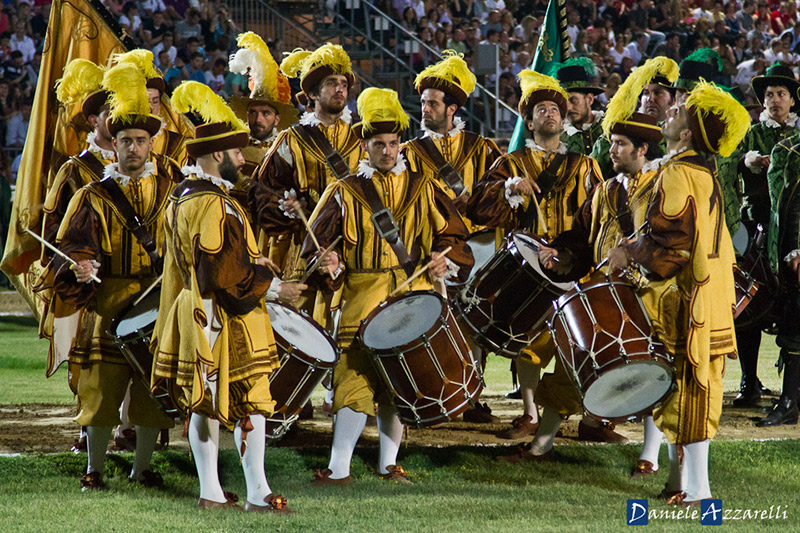
















The Quintana of Foligno
A joyous competition, an exciting challenge, and a city clothed in a glorious past

Where

June and September are very special months in Foligno. It happens, in fact, that at some point during both of these periods the city atmosphere changes. People are more cheerful, but also busy, in the streets appear stalls de tables that little by little create ancient taverns and markets, until the point when among friends we no longer talk about the results of the latest soccer matches, but about rings, flags, horses and districts. And that's when everything is ready: the Quintana of Foligno begins.
 The race course, also called Campo de li Giochi
The race course, also called Campo de li GiochiThe Challenge and the Revenge
The Quintana is somewhere between a historical reenactment that harkens back to the 17th century, and a modern city tradition strongly felt by the population. The actual game, in fact, is inspired by events that occurred in 1613 when, by order of the city's priors, the Joust of the Quintana was first established. The nobleman Ettore Tesorieri, chancellor and notary of the municipality, in charge of drawing up the rules, gave birth to one of the most famous and beloved knightly events in Italy. This tradition was lost for a few years, exhumed only in 1946, when it became a must-see event. An event that fills the streets of the historic center of Foligno twice a year: the first, called "La Sfida" is held in June, the second called "La Rivincita" takes place in September.
 Stunts in the saddle to avoid knocking down the flag
Stunts in the saddle to avoid knocking down the flagA most difficult race
Both the Challenge and the Revenge see the most skilled horsemen from the city's districts, competing in what is perhaps the most difficult ancient joust in Italy. Indeed, the feat requires a great deal of skill on the part of the rider, who must be able to lead his horse with extreme precision and speed and who must also have excellent aim. The competition takes place in an arena where a course is set up in the shape of an 8 bounded by flags. At the intersection point of the course is a puppet representing the god Mars with a raised fist, and from his very fist hangs a ring. The rider, armed with a spear, must ride the track as fast as possible without knocking down any flags. When he reaches the intersection he threads the ring with his spear and continues his ride, repeating it three times. Each ring threaded is promptly replaced by an assigned judge. Only those who have completed this first round perfectly will be eligible to enter the second and then, if they have still been flawless, the third. Each round is more difficult than the previous one because the rings get smaller and smaller. The pair that has passed all the rounds without fail will be the winner of the palio.
 Ladies and gentlemen in procession
Ladies and gentlemen in processionA celebration for the whole city
A very special feature of the Foligno Quintana lies in the spirit with which the event is experienced. The ten districts that participate in the joust do their best to excel in the challenge, but it is all experienced with the joy of a celebration that allows the city to gather in the squares and streets to be happy and carefree. The air one breathes is not strained by the expectations and anxieties associated with the competition, rather it is made sparkling by the cheerfulness and novelty that the Quintana brings with it compared to other days of the year. A rather atypical fact when compared to other Stakes in Italy, which can be explained by looking at the date when the event was brought back to life: 1946. World War II had recently ended, Foligno had suffered intense bombardment, the population was at the point of exhaustion and needed something to restore its former cheerfulness and lightheartedness, and that something was precisely the Quintana, a symbol of a new peace and serenity ever since. This is also clearly stated in the proclamation that announces the Joust at each edition: "All descend ne le Piazze, ne le Vie e nel Campo de li Giochi! / And make merry your knights! All hasten, O people of the Rioni, / All hasten to rejoice in Victory, even if it comes from others, / For the concord and love of the whole City are still Victory and beautiful and great!"
 Tamburini
TamburiniLet's face it: such a heartfelt invitation cannot be ignored, and so pack your bags and come and immerse yourself in the Foligno of 1613, in the flavors of its traditional dishes offered by the taverns, in the festive and incessant rolling of the drummers, in the sumptuous graces of the clothes of ancient fashions; follow the procession, take your place in the stands around the competition field and listen: do you hear it? Your own heart beats to the rhythm of that of the horses speeding past before your eyes.
Enter the Map of Italy's Undiscovered Wonders and find treasures where you least expect it... Inspire, Recommend, Share...
Collections
The Map thanks:
In the Community
Enter the Map of Italy's Undiscovered Wonders and find treasures where you least expect it... Inspire, Recommend, Share...
Where

Collections

